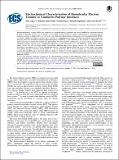Electrochemical Characterization of Biomolecular Electron Transfer at Conductive Polymer Interfaces
Author(s)
Agee, Alec; Gill, Thomas Mark; Pace, Gordon; Segalman, Rachel; Furst, Ariel
DownloadPublished version (774.0Kb)
Publisher with Creative Commons License
Publisher with Creative Commons License
Creative Commons Attribution
Terms of use
Metadata
Show full item recordAbstract
Bio-electrochemical systems (BESs) are promising for renewable energy generation but remain hindered by inefficient electron transfer at electrode surfaces. As the toolbox of bio-anode materials increases, rigorous electrochemical characterization of emerging materials is needed. Here, we holistically characterize the electrochemical interaction of flavin mononucleotide (FMN), an electron shuttle in biological systems and a cofactor for oxidoreductase enzymes, with the bio-inspired mixed conducting polymer poly{3-[6'-(N-methylimidazolium)hexyl]thiophene} (P3HT-Im+). The behavior of this polymer is compared to the equivalent polymer without the histidine-like imidazolium. We find improved conductivity and charge storage in imidazolium-containing polymers beyond what is explained by differences in the electroactive area. The P3HT-Im+ further shows internal charge storage but with negligible faradaic contribution, indicating that charge storage capacity may translate to improved biocatalysis non-intuitive ways. Finally, one-electron transfer is observed between FMN and glassy carbon, while a bio-similar two-electron transfer is observed for the P3HT-Im+. To our knowledge, this is the first example of a concerted two-electron transfer between FMN and an electrode interface, which we attribute to the bio-inspired, histidine-like imidazolium functional groups in the polymer. These studies demonstrate the importance of bio-relevant materials characterization when such materials are deployed in BESs.
Date issued
2023-01-01Department
Massachusetts Institute of Technology. Department of Chemical EngineeringJournal
Journal of The Electrochemical Society
Publisher
The Electrochemical Society
Citation
Alec Agee et al 2023 J. Electrochem. Soc. 170 016509
Version: Final published version